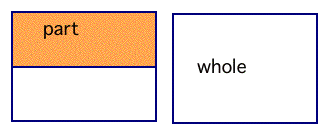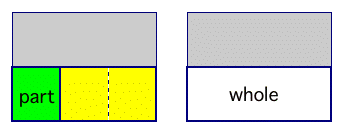

Often, we are given a whole, and we need to find part of it. The plant problem involved two such tasks
| -First, representing half of an unknown whole (for the answer, I drew a rectangle to represent the unknown whole) |  |
| -Second, representing 1/3 of the new whole which was half of the previous unknown whole: |  |
When we represent a part of a whole, we generally show the subdivisions into equal parts that let us compare the part to the whole.
You can print a paper copy of these questions to try yourself, and then move your cursor over the solution graphics to see my solutions
Notice that in all of my solutions, I showed the breakdown of the whole into the number of pieces given by the denominator. This is a good strategy to help make your solution clear to your audience.
When you break down a whole into eighths or thirds or fifths, each piece is one eighth or one third or one fifth. These fractions (with 1 in the numerator) are sometimes called unit fractions. We use the size of a unit fraction as our benchmark in deciding what size the whole fraction should be.